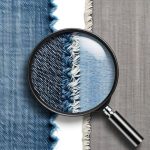Are you wondering how to determine if the cotton fabric you’re about to buy is truly organic? Look no further!
In this article, we will guide you through the process of identifying organic cotton fabric. Understanding the importance of organic certifications and learning how to spot genuine labels and tags are just some of the topics we will cover.
You’ll also gain insights on differentiating between organic and conventional cotton, as well as tips for spotting fake organic cotton fabric.
Get ready to make informed choices!
Table of Contents
The Importance of Organic Cotton Fabric
The importance of organic cotton fabric can’t be overstated in terms of environmental sustainability and human health.
Choosing organic cotton fabric has numerous benefits. First and foremost, it is grown without the use of harmful pesticides and synthetic fertilizers, which reduces the risk of exposure to toxic chemicals for both farmers and consumers.
Conventional cotton production is known to have a significant environmental impact. It uses a large amount of water and contributes to soil degradation and water pollution due to the use of chemical fertilizers and pesticides. On the other hand, organic cotton farming promotes soil fertility, water conservation, and biodiversity.
Additionally, organic cotton fabric is hypoallergenic and gentle on the skin, making it a healthier option for those with sensitive skin or allergies.
By choosing organic cotton fabric, you are not only making a positive impact on the environment but also prioritizing your own well-being.
Understanding Organic Certifications for Cotton
Understanding organic certifications can help you choose the right cotton fabric. When shopping for organic cotton products, it’s important to look for certifications that guarantee the fabric is made from organic cotton. These certifications ensure that the cotton was grown without the use of harmful chemicals, pesticides, or genetically modified organisms (GMOs).
One of the most recognized certifications for organic cotton is the Global Organic Textile Standard (GOTS). GOTS ensures that every step of the production process, from farming to manufacturing, meets strict organic and environmental standards. Another certification to look for is the Organic Content Standard (OCS), which verifies the percentage of organic material in a product.
Understanding these certifications can help you make an informed decision when choosing organic cotton fabric. By opting for organic cotton, you are supporting sustainable farming practices and protecting the environment. Organic cotton production uses less water and reduces soil erosion, making it a more eco-friendly choice. Additionally, organic cotton is free from harmful chemicals, making it safer for your skin and overall health.
Identifying Organic Cotton Through Labels and Tags
When shopping for organic cotton products, it’s important to look for labels and tags that indicate the fabric’s organic certification. These labels and tags serve as a guarantee that the cotton was grown and processed without the use of synthetic chemicals or genetically modified organisms.
To help you identify organic cotton through labels and tags, here are four key things to look for:
-
Organic Certification Seal: Look for labels that display recognized organic certification seals, such as the Global Organic Textile Standard (GOTS) or the Organic Content Standard (OCS). These seals ensure that the cotton has met strict standards for organic production.
-
Fiber Composition: Check the label for information on the fabric’s fiber composition. Organic cotton should be listed as the primary fiber, indicating that it makes up the majority of the fabric.
-
Soft and Natural Texture: Organic cotton tends to have a softer and more natural texture compared to conventional cotton. Feel the fabric and look for a smooth and slightly textured surface.
-
Transparent Supply Chain: Look for information on the label or tag about the brand’s commitment to a transparent supply chain. Brands that prioritize organic cotton often provide details about their sourcing practices and partnerships with certified organic farmers.
Differentiating Between Organic and Conventional Cotton
To distinguish between organic and conventional cotton, feel the texture and look for any noticeable differences. Organic cotton is grown without the use of synthetic fertilizers, pesticides, or genetically modified organisms (GMOs), making it a more sustainable and environmentally friendly choice. Conventional cotton, on the other hand, is often treated with chemicals that can be harmful to both the environment and human health.
One way to differentiate between the two types of cotton is by looking at the fabric composition. Organic cotton is typically labeled as such and may also carry certifications from organizations such as the Global Organic Textile Standard (GOTS). These certifications ensure that the fabric meets certain environmental and social criteria throughout the entire production process.
Another way to identify organic cotton is by considering its environmental impact. Organic cotton farming practices promote soil health, water conservation, and biodiversity, while conventional cotton farming contributes to water pollution, soil degradation, and the loss of natural habitats.
Here is a table summarizing the key differences between organic and conventional cotton:
| Organic Cotton | Conventional Cotton |
|---|---|
| Grown without synthetic fertilizers, pesticides, or GMOs | Treated with chemicals |
| Certified by organizations such as GOTS | Not certified |
| Promotes soil health, water conservation, and biodiversity | Contributes to water pollution, soil degradation, and loss of habitats |
Tips for Spotting Fake Organic Cotton Fabric
By feeling the texture and looking for any noticeable differences, you can quickly spot fake organic cotton fabric. Here are four common signs of counterfeit organic fabric to watch out for:
-
Inconsistent texture: Genuine organic cotton fabric has a soft and slightly rough texture, while fake organic fabric may feel smoother or have an unnatural sheen. Run your fingers along the fabric and pay attention to any inconsistencies in texture.
-
Lack of certifications: Authentic organic cotton fabric should come with certifications from recognized organizations, such as the Global Organic Textile Standard (GOTS) or the Organic Content Standard (OCS). Check for these certifications on the fabric label or ask the seller for proof.
-
Synthetic fiber blend: Fake organic cotton fabric may contain synthetic fibers blended with organic cotton to reduce costs. Look for labels that mention a blend of fibers or examine the fabric closely for any unnatural shine or stretchiness.
-
Suspiciously low price: Counterfeit organic cotton fabric is often sold at significantly lower prices than genuine organic fabric. If the price seems too good to be true, there’s a high chance that the fabric is not authentic.
Conclusion
In conclusion, identifying organic cotton fabric is crucial for those who value sustainable and eco-friendly practices. By understanding organic certifications and examining labels and tags, you can ensure that the cotton fabric you purchase is truly organic.
Differentiating between organic and conventional cotton can be challenging, but with careful observation and knowledge, you can spot the differences.
Lastly, be aware of fake organic cotton fabric by following helpful tips. By taking these steps, you can make informed choices and support the organic cotton industry.
- How Does Ring Spun Cotton Affect Garment Fit and Shape Retention? - August 13, 2024
- What Are the Challenges in Producing Ring Spun Cotton? - August 13, 2024
- Is Ring Spun Cotton Suitable for Plus-Size Clothing? - August 13, 2024





